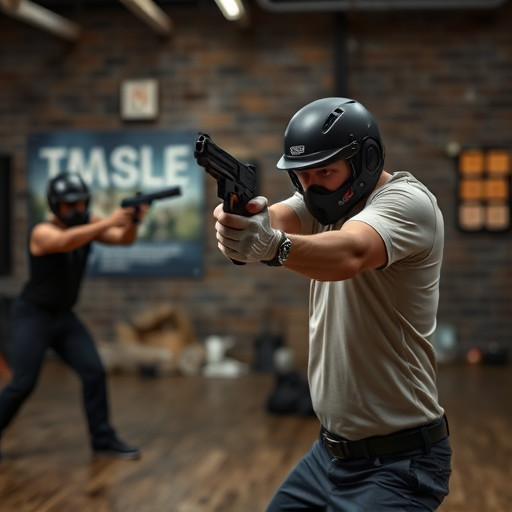Concealable Stun Guns for Women: Voltage, Safety, & Effectiveness Explored
When choosing concealable stun guns for women's personal safety, consider voltage range (50,000…….
When choosing concealable stun guns for women's personal safety, consider voltage range (50,000-150,000 volts) for maximum impact while minimizing harm. These devices, designed with comfort and discretion in mind, feature automatic shut-offs and adhere to industry standards set by IEC and UL. Effective use requires understanding power settings, target contact points, and best practices for safety and maintenance, as these guns complement self-defense training rather than replace it.
In today’s world, personal safety is paramount, especially for women seeking effective self-defense tools. Concealable stun guns have emerged as a popular choice, offering a discrete yet powerful means of deterring potential threats. This article delves into the critical aspect of stun gun voltage, exploring the range and its implications for user safety. We’ll examine industry standards, factors influencing effectiveness, best practices, and specifically focus on concealable stun guns designed for women’s unique needs.
- Understanding Stun Gun Voltage: What It Means for Safety
- Concealable Stun Guns: Features and Design Considerations for Women
- Industry Standards and Regulations for Stun Gun Voltage Range
- Factors Affecting Stun Gun Effectiveness and Safety
- Best Practices for Stun Gun Use and Maintenance
Understanding Stun Gun Voltage: What It Means for Safety

When considering concealable stun guns, especially designed for women’s personal safety, understanding voltage range is paramount. Voltage, measured in watts or volts, represents the electrical force delivered by the stun gun to disrupt an assailant’s mobility. Stun guns typically operate within a specific voltage range, usually between 50,000 and 150,000 volts. This high voltage ensures effective immobilization without causing serious harm.
For women looking for concealed protection, knowing the stun gun’s voltage range offers insights into safety features. Lower voltages may be sufficient for less intense situations, while higher voltages provide more power when facing larger or more aggressive threats. As with any self-defense tool, it’s crucial to understand usage limitations and legal considerations regarding stun gun voltage in your region.
Concealable Stun Guns: Features and Design Considerations for Women

Concealable stun guns designed specifically for women offer a discreet and powerful self-defense option. These devices prioritize comfort, ease of use, and compact design elements to facilitate easy concealment. Features such as lightweight construction, ergonomic grip patterns, and durable yet sleek materials enable users to carry their stun gun with confidence, knowing it can be easily accessed in an emergency.
When selecting a concealable stun gun for self-defense, women should consider factors like voltage range—typically between 50,000 and 150,000 volts—to ensure maximum impact and stop an attacker. Additionally, looking for models with built-in safety features, such as automatic shut-off mechanisms after deployment, can help prevent accidental discharge. The best stun guns for women blend form and function, providing a powerful personal safety tool that fits seamlessly into their daily lives.
Industry Standards and Regulations for Stun Gun Voltage Range

In the realm of personal safety, particularly for women seeking concealed protection, stun guns have emerged as a powerful tool. When considering concealable stun guns, understanding industry standards and regulations regarding voltage range is paramount. These standards ensure that the devices are both effective and safe in use. The International Electrotechnical Commission (IEC) and Underwriters Laboratories (UL) are two key organizations setting global benchmarks for stun gun safety.
According to these guidelines, a stun gun’s voltage should typically range between 50,000 and 150,000 volts. This specific range is designed to immobilize an attacker without causing permanent harm. Regulations also dictate safety features such as automatic shut-off mechanisms after a certain discharge time to prevent accidental or unauthorized use. Such measures ensure that women carrying concealable stun guns for personal protection can do so with peace of mind, knowing their device meets established industry standards tailored to their safety needs.
Factors Affecting Stun Gun Effectiveness and Safety

The effectiveness and safety of stun guns, especially concealable ones designed for women’s personal defense, are influenced by several key factors. One primary consideration is voltage range. Stun guns deliver an electric shock through a probe that makes contact with the target, and higher voltage typically results in a more powerful stun. However, it’s crucial to balance this with safety. Too high a voltage can increase the risk of injury, especially for individuals with heart conditions or those using the device on larger targets like men.
Another critical factor is the device’s contact point. Concealable stun guns often feature probes that are designed to make quick, efficient contact. The shape and size of these probes affect both the stun’s effectiveness and safety. Smaller probes may be easier to conceal but could require precise targeting to ensure a strong shock. Larger probes can cover more area, potentially rendering the target immobile faster, but they also increase the likelihood of off-target shocks or accidental injuries, especially in crowded spaces.
Best Practices for Stun Gun Use and Maintenance

When carrying a concealable stun gun, designed specifically for women’s self-defense needs, it’s vital to prioritize safety and proper usage. These compact devices pack a powerful punch, but users must be well-versed in their functionality to ensure effectiveness and minimize risks. Regular maintenance is key; keeping your stun gun clean and properly charged guarantees optimal performance when you need it most.
Best practices include familiarizing yourself with the device’s range and power settings, understanding safe storage methods, and learning proper deployment techniques. Always remember: a stun gun is not a substitute for self-defense training, but rather a tool to enhance your capabilities. Stay alert, be prepared, and ensure you’re using your concealable stun gun responsibly and safely.
When choosing a concealable stun gun for women, understanding voltage range safety specs is paramount. Following industry standards and considering factors like power and accuracy ensures effectiveness in self-defense situations. By adopting best practices for use and maintenance, users can ensure their stun guns remain reliable tools for personal safety. Remember, the right stun gun, paired with knowledge and preparation, can empower women to navigate potential threats with confidence.


